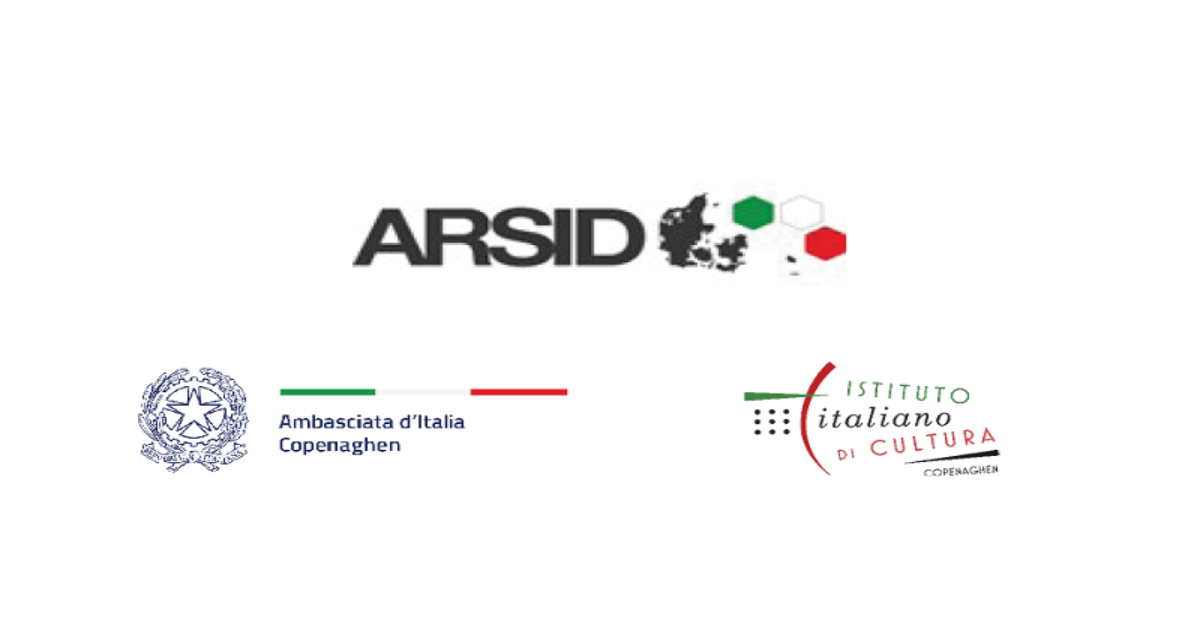“What can help Italians and other foreigners to speak Danish?”
- 22 maj2024

ARSID (Associazione Ricercatori e Scienziati Italiani in Danimarca - Association of Italian Researchers and Scientists in Denmark) invites to a seminar, where ARSID members and other interested individuals will meet experts in the field of spoken language for a series of presentations illustrating the differences between Danish and other languages such as, e.g., Italian. These differences are a challenge to Italians and other foreigners in achieving a proper Danish pronunciation. The experts will illustrate the challenges and address some
ways of reducing the problem. An open discussion accompanied by a glass of Italian wine will follow the presentations.
The event receives the support of the Italian Embassy in Denmark and of the Italian Institute of Culture in Denmark.
The event is held in English.
ARSID aims to be a meeting place for Italians who live in Denmark and work as researchers and scientists as well as Italian and Danish academics and professionals who live in Denmark and are interested in scientific and
technological interactions with Italy. ARSID also aims at promoting collaborations between scientists and scholars based at universities, research centres, private companies as well as governmental and non-governmental organisations in Italy and Denmark.
Program
| 18.00-18.10 | Welcome and introduction to the seminar by Leonardo De Chiffre, ARSID |
| 18.10-18.20 | Address by H.E. Stefania Rosini, Italian Ambassador to Denmark |
| 18.20-18.40 | ”Some challenges in learning to speak Danish” by John Tøndering, University of Copenhagen. Foreigners who learn Danish often reach high proficiency, enabling full participation in Danish society. However, some pronunciation features may remain challenging even after decades of residence. Rather than deficits, these features reflect unique attributes of Danish - its flat intonation, vowel reductions, and soft articulation. In this talk, I will explore how some of these pronunciation patterns shape communication in Danish. |
| 18.40-19.00 | “Cracking the Code: Unveiling the Influence of Opaque Sound Structures on Language Learning” by Fabio Trecca, Aarhus University Children acquire their native language(s) by tracking regularities in, and extracting patterns from, the linguistic input they receive from caregivers and peers. The surface properties of a language, including its constituent sounds, syllable structure, and stress patterns, form a large pool of cues from which children can deduce and generalize linguistic rules. However, spoken languages vary significantly in transparency, affecting the availability of these surface properties for computation. Spoken Danish, for instance, is characterized by pervasive phonetic reductions, resulting in a relatively opaque pronunciation compared to closely related languages. In this talk, I will discuss how being exposed to a language with an opaque sound structure can hinder language processing and |
| 19.00-19.20 | “The visual modality of language: gesture and speech in interaction” by Maria Graziano, Lund University Humanities Lab. Most research on language mainly focuses on speech. However, face-to-face communication is multimodal. Indeed, speakers often gesture when they talk, no matter what language they speak and what culture they belong to. In this talk, I will give an overview on the relationship between speech and gesture and the function of gestures in discourse. |
| 19.20-19.40 | “Audio-visual speech enhancement” by Daniel Michelsanti, Aalborg University Speech is perhaps the most common way that people use to communicate with each other. Often, this kind of communication is harmed by several sources of disturbance that may have different nature, such as the presence of competing speakers, the loud music during a party, and the noise inside a car cabin. In this talk, I will explore how the use of artificial intelligence algorithms can reduce the impact of such sources of disturbance in speech communication by exploiting visual information of the speaker (i.e. lip reading). |
| 19.40-20.00 | “Speech visualisation for Computer-Aided Pronunciation Training” by Jeppe R. Frisvad, DTU Compute Visual display of spectrograms as well as 2D and 3D computer animations of the lips and oral cavity can be beneficial for pronunciation learning. However, computer-aided pronunciation training (CAPT) systems often suffer from difficulties in giving learners adequate, accurate feedback and an inability to provide accurate diagnosis of pronunciation errors. We believe more advanced speech visualisation |
| 20.00-21.00 | Open discussion with speakers and participants. |
Dato
22 maj 2024 kl. 18:00
Sted
Det Italienske Kulturinstitut
Gjørlingsvej 11
2900 Hellerup
Danmark
Sprog
English
Tilmeldingsfrist
17 maj 2024
Pris
Attendance is free
Nina Munch, Tlf: +4539620696, E-mail: nina.munch@esteri.it